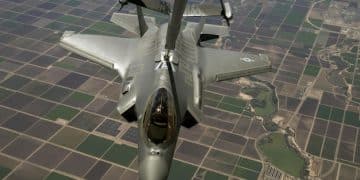US Response to North Korea Missile Tests: 4 Scenarios Analyzed

The United States faces complex diplomatic and military challenges in responding to North Korea’s recent missile tests, requiring a delicate balance between deterrence, de-escalation, and international cooperation to prevent further destabilization in the Korean Peninsula and broader Indo-Pacific region.
The recent surge in missile tests by North Korea has once again brought the precarious security situation on the Korean Peninsula into sharp focus. For the United States, this renewed display of Pyongyang’s military ambitions presents a formidable challenge, demanding a nuanced and strategic response. Understanding How Will the US Respond to the Latest North Korean Missile Tests? Analyzing 4 Possible Scenarios is critical for anyone interested in global affairs, as the choices made in Washington will undoubtedly shape the future of regional stability.
Understanding North Korea’s Provocations: A Pattern of Intent
North Korea’s missile program has evolved significantly over the past decades. What began as a nascent capability has transformed into a sophisticated arsenal, including short-range, medium-range, and increasingly, intercontinental ballistic missiles (ICBMs) capable of reaching the US mainland. These tests are not random acts; they are carefully calculated provocations, serving multiple purposes for the Kim Jong Un regime.
One primary objective is internal consolidation of power. By showcasing military might, Kim Jong Un reinforces his leadership and the necessity of his “songun” (military-first) policy. These demonstrations bolster national pride and divert attention from severe economic hardships. Externally, the tests are a direct message to the international community, particularly the United States and its allies, South Korea and Japan.
The Strategic Calculus Behind the Launches
Each missile launch is a data point for Pyongyang’s scientists and engineers, allowing them to refine capabilities, test new technologies, and improve precision. Beyond technical advancements, these tests serve as bargaining chips in future negotiations. North Korea seeks to compel the US and its allies to ease sanctions and offer security assurances, aiming for de facto recognition as a nuclear weapons state.
- Technological Advancement: Each test provides valuable data for missile refinement.
- Internal Legitimacy: Boosts domestic support for the regime.
- Bargaining Power: Used as leverage in diplomatic negotiations.
- Deterrence: Aims to deter potential attacks from adversaries.
The frequency and type of recent tests suggest a more aggressive posture, possibly driven by perceived weaknesses in the international order or a desire to exploit global distractions. Understanding these motivations is the first step in formulating an effective US response, as a misinterpretation could lead to unintended escalation.
From a US perspective, these provocations represent a direct challenge to its security interests and those of its key allies. Washington must weigh the immediate threat posed by these missiles against the long-term goal of denuclearizing the peninsula. The response cannot be merely reactive; it must be part of a comprehensive strategy that addresses underlying issues while maintaining credibility and deterring further aggression.
Scenario 1: Enhanced Diplomatic Engagement and Negotiation
One primary avenue for the US response involves doubling down on diplomatic efforts. This scenario posits that despite past failures and North Korea’s recalcitrance, sustained and creative diplomacy remains the most viable path to de-escalation and eventual denuclearization. This approach acknowledges that military options carry immense risks and that sanctions alone have not fully deterred Pyongyang.
Enhanced diplomatic engagement would likely involve direct talks, possibly at various levels, from working-level discussions to high-level summits. These wouldn’t be “talks for talks’ sake” but structured negotiations with clear agendas and benchmarks. The US might offer limited sanctions relief or humanitarian aid in exchange for concrete, verifiable steps towards denuclearization, such as halting missile tests, allowing international inspections, or even dismantling key nuclear facilities.
Multilateral Dialogue and Incentives
A key component of this scenario would be increased multilateral engagement, bringing together regional powers like China, South Korea, Japan, and Russia. A coordinated international front could present North Korea with a unified message and a package of incentives and disincentives. China’s role is particularly crucial, given its economic leverage over North Korea. Beijing could be persuaded to exert more pressure or offer its own incentives for cooperation.
- Direct Bilateral Talks: Engaging with North Korea on a sustained basis.
- Multilateral Frameworks: Utilizing formats like the Six-Party Talks (reinvigorated) to build consensus.
- Conditional Sanctions Relief: Offering economic benefits for verifiable denuclearization steps.
- Security Assurances: Providing non-hostile assurances in exchange for specific actions.
This path requires significant strategic patience and a willingness to compromise without conceding core security interests. The goal is to build trust incrementally, demonstrating to Pyongyang that there is a viable path to improved relations and economic prosperity if it genuinely commits to denuclearization. The challenge lies in North Korea’s consistent pattern of bad faith negotiations and its historical tendency to backtrack on agreements. However, persistent diplomacy might be the only way to avoid more dangerous outcomes.
The US would need to be prepared for setbacks and maintain flexibility in its approach. This scenario also implies a willingness to engage with North Korea as a sovereign entity, rather than continuously isolating it. Success would be measured not by immediate denuclearization, but by a progressive reduction in the threat posed by North Korea’s WMD programs.
Scenario 2: Increased Sanctions and Economic Pressure
Historically, sanctions have been a cornerstone of the US and international response to North Korea’s nuclear and missile programs. This scenario suggests a significant escalation of these existing efforts, aiming to cripple Pyongyang’s ability to fund its weapons development and compel it to return to the negotiating table under duress. The rationale is that economic pain will eventually force the regime to alter its behavior.
This approach would involve tightening existing sanctions, closing loopholes, and imposing new, more stringent measures. This could target specific sectors of the North Korean economy not yet fully covered, individuals involved in illicit finance, or even third-country entities that facilitate North Korea’s illegal activities (secondary sanctions). The goal is to cut off Pyongyans access to hard currency, technology, and materials necessary for its weapons programs.

Enforcing and Expanding Sanctions
Effective implementation of this scenario requires robust enforcement mechanisms and strong international cooperation. The US would likely lean heavily on its allies, particularly South Korea and Japan, and engage with the United Nations Security Council to ensure widespread adherence. This could include increased surveillance of shipping lanes to intercept illegal cargo, cracking down on cyber-enabled illicit finance, and pressuring countries that host North Korean laborers or businesses.
- Expanded UN Sanctions: Pushing for new Security Council resolutions.
- Secondary Sanctions: Targeting entities in other countries doing business with North Korea.
- Maritime Interdiction: Enhancing efforts to stop illicit trade by sea.
- Cyber Finance Disruption: Combating North Korea’s cyber theft and money laundering.
The effectiveness of sanctions is often debated. While they have undoubtedly impacted North Korea’s economy, they have not, to date, halted its weapons development. The regime has proven adept at circumventing restrictions and prioritizing its military programs over civilian welfare. However, advocates of this approach argue that increased pressure, combined with better enforcement, could eventually reach a tipping point.
Challenges include potential humanitarian consequences, as sanctions can exacerbate the suffering of ordinary North Koreans, and the risk of further escalating tensions if Pyongyang views the pressure as an existential threat. Moreover, securing full compliance from all nations, especially China and Russia, remains a persistent hurdle. Nevertheless, economic pressure continues to be a go-to tool in the US foreign policy arsenal when dealing with rogue states.
Scenario 3: Enhanced Military Deterrence and Readiness
In response to North Korea’s escalating missile capabilities, another significant scenario for the US involves primarily bolstering its military posture and enhancing readiness in the region. This approach emphasizes deterrence through strength, aiming to dissuade North Korea from future provocations or military action by demonstrating overwhelming military superiority and the readiness to respond forcefully.
This scenario would likely entail a visible increase in US military assets in and around the Korean Peninsula. This could include deploying more advanced missile defense systems (like THAAD or Patriot batteries), conducting larger and more frequent joint military exercises with South Korea and Japan, and potentially increasing the presence of strategic assets such as aircraft carriers, stealth fighters, and long-range bombers. The message is clear: any aggression will be met with a decisive and devastating response.
Strengthening Alliances and Capabilities
A crucial element of enhanced deterrence is strengthening the alliances with South Korea and Japan. This involves greater intelligence sharing, integrated command structures, and joint development of military technologies. The US might also provide its allies with more advanced weaponry or approve their development of more robust deterrent capabilities, within the framework of existing treaties.
- Increased Military Exercises: Larger and more frequent joint drills.
- Deployment of Advanced Defenses: Bolstering missile defense capabilities.
- Strategic Asset Presence: Regular rotation of powerful US military hardware.
- Alliance Integration: Deeper coordination on defense planning and response.
While this scenario aims to prevent conflict through deterrence, it carries inherent risks. A more aggressive military posture could be perceived by North Korea as an escalatory step, potentially leading to miscalculation or an unintended armed confrontation. Pyongyang might interpret increased drills or deployments as preparations for an attack, prompting a pre-emptive strike or further provocative missile tests in response.
Furthermore, maintaining a heightened military presence is costly and places strain on regional stability. It requires careful management to avoid a spiraling arms race or a permanent state of high alert. Despite these challenges, proponents argue that a strong military posture is essential to ensure regional stability and protect US interests. It provides a credible backup to diplomatic efforts, demonstrating that the US has options beyond negotiation.
Scenario 4: Limited or Targeted Retaliation to Provocations
This scenario represents a significant shift from the previous three, moving beyond deterrence and economic pressure to a more direct, yet contained, military response. A limited or targeted retaliation would occur if North Korea’s provocations crossed a specific threshold, perhaps by firing a missile too close to allied territory, conducting a nuclear test, or directly attacking South Korean or US assets.
Such a response would be carefully calibrated to send a clear message without initiating a full-scale conflict. Examples might include precision strikes against North Korean missile launch sites after a test, cyberattacks to disrupt their command and control systems, or interdicting vessels involved in illicit trade. The objective is punitive: to impose a cost on North Korea for its actions, demonstrating that its provocations will not go unanswered. The key is proportionality and avoiding unintended escalation.
Defining Red Lines and Managing Escalation
For this scenario to be effective, the US would need to clearly define its “red lines” to North Korea, allowing Pyongyang to understand the consequences of specific actions. However, communicating these lines is fraught with peril. If too vague, they are ineffective; if too specific, they might invite testing. Managing escalation is paramount. Any military action, no matter how limited, carries the risk of unintended consequences and a broader conflict.
- Precision Strikes: Targeting specific military assets or launch sites.
- Cyber Countermeasures: Disrupting North Korean cyber capabilities.
- Naval Interdiction: Blocking illicit shipments with force if necessary.
- Clear Messaging: Communicating the punitive nature of the response to prevent misinterpretation.
The risks associated with this scenario are substantial. North Korea possesses a large conventional military, and any direct military engagement could quickly spiral out of control, leading to a devastating conflict on the Korean Peninsula. The humanitarian cost would be immense. Furthermore, such an action could galvanize North Korean nationalism and solidify the regime’s grip on power, making future denuclearization efforts even more difficult.
Despite the high risks, some analysts argue that a failure to respond militarily to certain provocations emboldens North Korea and indicates a lack of resolve. This scenario would only be considered a last resort, debated with extreme caution within US leadership, and weighed against the potential for catastrophic outcomes. It would fundamentally alter the dynamics on the Korean Peninsula and the broader geopolitical landscape.
Evaluating the Interplay of Scenarios and Hybrid Approaches
While the four scenarios present distinct paths, in reality, a US response to North Korea’s missile tests is unlikely to be confined to a single, isolated approach. Geopolitical strategies often involve a blend of tactics, adapting to the evolving situation and leveraging various tools simultaneously. A hybrid approach, integrating elements from diplomatic engagement, economic pressure, and military deterrence, is perhaps the most probable outcome.
For instance, the US might intensify sanctions while simultaneously signaling a willingness to engage in dialogue under specific conditions. Or, it could bolster its military posture to strengthen its negotiating hand, combining “talk while deterring” tactics. Each test from Pyongyang presents a new data point, prompting recalibrations in Washington’s strategy rather than a rigid adherence to one course of action.
Challenges of Implementation and Coordination
Implementing a hybrid approach is complex. It requires meticulous coordination between various government agencies—the State Department, Department of Defense, Treasury, intelligence agencies, among others. Furthermore, securing the consistent support and cooperation of key allies like South Korea and Japan, and managing the responses of major powers like China and Russia, is crucial.
- Interagency Coordination: Seamless collaboration among US government bodies.
- Alliance Unity: Maintaining strong, unified fronts with South Korea and Japan.
- Managing Great Power Dynamics: Navigating the interests of China and Russia.
- Public and International Opinion: Shaping narratives and building consensus.
The public perception and international legitimacy of the US response are also vital considerations. Any action, whether diplomatic, economic, or military, must be viewed as legitimate and proportionate. This involves careful communication strategies, both to domestic audiences and to the international community. The long game in dealing with North Korea is not about quick fixes but about sustained, adaptable pressure and engagement.
Ultimately, the US response will be a dynamic interplay of perceived threats, available resources, domestic political considerations, and the intricate dynamics of international relations. No single scenario offers a perfect solution; instead, the art of statecraft lies in strategically combining these elements to minimize risk, maximize leverage, and navigate the complex path towards a more stable Korean Peninsula.
| Key Aspect | Brief Description |
|---|---|
| 🤝 Diplomacy | Focus on negotiations, direct talks, and multilateral engagement to de-escalate tensions and seek denuclearization. |
| 💰 Sanctions | Increased economic pressure, stricter enforcement, and new measures to limit Pyongyang’s access to funds for its WMD programs. |
| 🛡️ Deterrence | Bolstering military presence, advanced missile defenses, and joint exercises to dissuade North Korean aggression. |
| 💥 Retaliation | Consideration of limited, targeted military responses to specific provocations, with high risks of escalation. |
Frequently Asked Questions
North Korea tests missiles for several reasons: to advance its military technology, enhance domestic legitimacy for its leadership, gain leverage in international negotiations, and demonstrate its capabilities to deter potential adversaries. Each test serves as a crucial data point for refining their expanding arsenal, contributing to both strategic and technical objectives.
A military response from the US, even a limited one, carries substantial risks. These include rapid escalation into a full-scale conflict on the Korean Peninsula, potentially leading to millions of casualties. There’s also the danger of miscalculation, unintended consequences, and further destabilization of the entire region, impacting global economies and security.
China is North Korea’s primary economic and political backer, making its influence significant. Beijing’s cooperation is crucial for the effectiveness of international sanctions. While China has sometimes supported sanctions, it often prioritizes regional stability over strict adherence, fearing regime collapse and a refugee crisis, thus often limiting the extent of pressure it’s willing to apply.
South Korea and Japan are frontline US allies, directly threatened by North Korea’s missile programs. They play a critical role in intelligence sharing, joint military exercises, and hosting US forces. Their perspectives heavily influence US strategy, balancing between the need for deterrence and the imperative to avoid actions that could provoke a devastating conflict on their doorsteps.
While economic sanctions have impacted North Korea’s economy, they largely haven’t achieved denuclearization. The regime has shown a remarkable ability to circumvent restrictions and prioritize its weapons programs, often at the expense of its population. Sanctions alone are often insufficient, needing to be combined with diplomatic overtures or other pressures to be more effective in altering Pyongyang’s strategic calculus.
Conclusion: Navigating a Perilous Path
North Korea’s ongoing missile tests represent a multifaceted and enduring challenge for the United States and the international community. There is no simple solution, and each potential response scenario carries its own set of advantages and inherent risks. From patient diplomacy and tightened economic screws to robust military deterrence and even the remote possibility of targeted retaliation, Washington’s toolkit is diverse, but its application demands extreme caution and strategic foresight. The preferred path will likely be a dynamic one, integrating elements from these scenarios and adapting to Pyongyang’s unpredictable behavior. The ultimate goal remains a denuclearized Korean Peninsula, achieved without resorting to catastrophic conflict, a delicate balance that US policy must continually strive to maintain.





